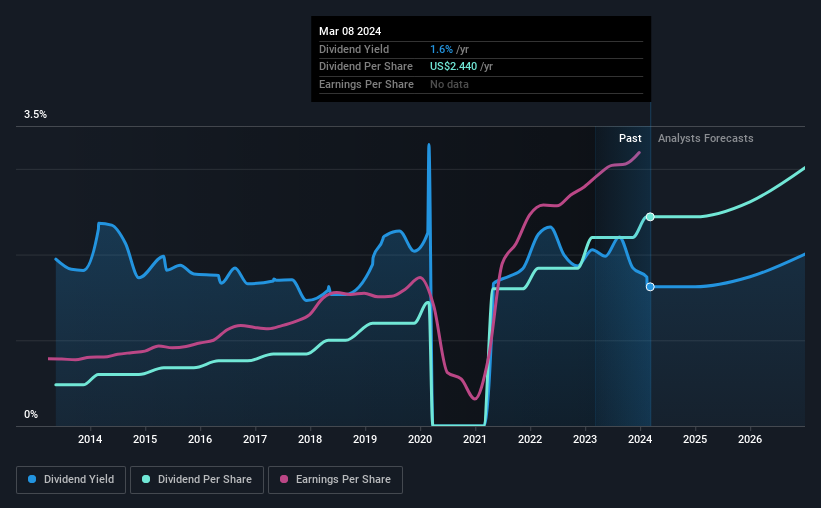Texas Roadhouse (NASDAQ:TXRH) Could Be A Buy For Its Upcoming Dividend
Texas Roadhouse, Inc. (NASDAQ:TXRH) stock is about to trade ex-dividend in 3 days. The ex-dividend date is usually set to be one business day before the record date which is the cut-off date on which you must be present on the company's books as a shareholder in order to receive the dividend. It is important to be aware of the ex-dividend date because any trade on the stock needs to have been settled on or before the record date. Therefore, if you purchase Texas Roadhouse's shares on or after the 12th of March, you won't be eligible to receive the dividend, when it is paid on the 26th of March.
The company's next dividend payment will be US$0.61 per share, and in the last 12 months, the company paid a total of US$2.20 per share. Last year's total dividend payments show that Texas Roadhouse has a trailing yield of 1.6% on the current share price of US$150.29. Dividends are an important source of income to many shareholders, but the health of the business is crucial to maintaining those dividends. So we need to investigate whether Texas Roadhouse can afford its dividend, and if the dividend could grow.
See our latest analysis for Texas Roadhouse
Dividends are typically paid from company earnings. If a company pays more in dividends than it earned in profit, then the dividend could be unsustainable. Fortunately Texas Roadhouse's payout ratio is modest, at just 48% of profit. A useful secondary check can be to evaluate whether Texas Roadhouse generated enough free cash flow to afford its dividend. It paid out more than half (68%) of its free cash flow in the past year, which is within an average range for most companies.
It's encouraging to see that the dividend is covered by both profit and cash flow. This generally suggests the dividend is sustainable, as long as earnings don't drop precipitously.
Click here to see the company's payout ratio, plus analyst estimates of its future dividends.
Have Earnings And Dividends Been Growing?
Companies with consistently growing earnings per share generally make the best dividend stocks, as they usually find it easier to grow dividends per share. If earnings fall far enough, the company could be forced to cut its dividend. For this reason, we're glad to see Texas Roadhouse's earnings per share have risen 16% per annum over the last five years. Texas Roadhouse has an average payout ratio which suggests a balance between growing earnings and rewarding shareholders. Given the quick rate of earnings per share growth and current level of payout, there may be a chance of further dividend increases in the future.
Many investors will assess a company's dividend performance by evaluating how much the dividend payments have changed over time. Since the start of our data, 10 years ago, Texas Roadhouse has lifted its dividend by approximately 18% a year on average. Both per-share earnings and dividends have both been growing rapidly in recent times, which is great to see.
Final Takeaway
Has Texas Roadhouse got what it takes to maintain its dividend payments? Earnings per share have grown at a nice rate in recent times and over the last year, Texas Roadhouse paid out less than half its earnings and a bit over half its free cash flow. There's a lot to like about Texas Roadhouse, and we would prioritise taking a closer look at it.
While it's tempting to invest in Texas Roadhouse for the dividends alone, you should always be mindful of the risks involved. Every company has risks, and we've spotted 2 warning signs for Texas Roadhouse you should know about.
A common investing mistake is buying the first interesting stock you see. Here you can find a full list of high-yield dividend stocks.
Have feedback on this article? Concerned about the content? Get in touch with us directly. Alternatively, email editorial-team (at) simplywallst.com.
This article by Simply Wall St is general in nature. We provide commentary based on historical data and analyst forecasts only using an unbiased methodology and our articles are not intended to be financial advice. It does not constitute a recommendation to buy or sell any stock, and does not take account of your objectives, or your financial situation. We aim to bring you long-term focused analysis driven by fundamental data. Note that our analysis may not factor in the latest price-sensitive company announcements or qualitative material. Simply Wall St has no position in any stocks mentioned.

